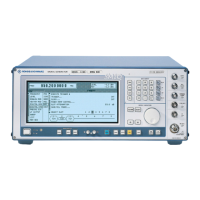SMIQ Noise Generator and Distortion Simulator
1125.5555.03 2.383 E-9
2.24 Noise Generator and Distortion Simulator
The noise generator and the distortion simulator (Option SMIQB17) perform the following two functions:
• Addition of noise to the SMIQ output level. Since the C/N can be finely varied, different reception
conditions can be realistically simulated.
• Simulation of TWTA (traveling wave tube amplifier) distortion of satellite. The signal received by the
satellite is strongly distorted and thus more difficult to demodulate than an undistorted signal. Real
reception conditions can be simulated with the distortion simulator and the receivers can thus be
tested realistically.
The noise generator outputs an AWGN signal (Additive White Gaussian Noise) , ie the noise power ratio
is Gaussian-distributed and the noise signal is added to the signal.
Distortion is performed via AM/AM conversion and AM/PM conversion. The respective characteristics
can be loaded or modified via IEC/IEEE bus.
I
Q
Distortion
AM/AM conversion
AM/PM conversion
Noise
generator
Noise
generator
I
Q
in out
in
I
Q
out
Fig. 2-237 Block diagram of noise generator and distortion simulator
The noise generator and distortion simulator are independent functional units and can be operated
separately. They exclusively use baseband signals I and Q. Both external I/Q signals and I/Q signals
internally generated by the modulation coder can be distorted and superimposed with noise. The noise
generator can also be switched on if internal and external modulation are switched off. The unmodulated
carrier is then superimposed with the noise signal.
sin( t)
ω
cos( t)
ω
I
Q
ext
ext
RF OUT
IQ modulator
Modulation
coder
IQ
AUX
Option
Fading
Simulator
SMIQB14
Noise
generator
Distortion
simulator
Fig. 2-238 Noise generator and distortion simulator in the SMIQ

